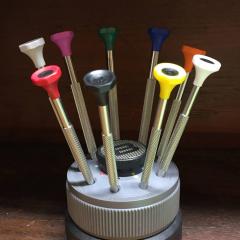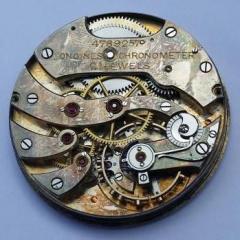Leaderboard
Popular Content
Showing content with the highest reputation on 12/31/17 in all areas
-
It might just be the photo but it does look like the hour and minute wheels are not meshing correctly on your pic? if not as said above it could be the cannon pinion which is too loose, and just slips instead of turning with the centre wheel.1 point
-
Ok the Horotec is a great tool very versatile and with a great solid build. However at the very begining of this post I was under the impression that it was not a Rolex or Diver that is why I suggested an alternative option. I have 3 different openers (excluding a case knife) I have a vintage Bergeron style opener which I normally use sometimes I use the Jaxa and always use the Horotech for Rolex or real tight ones etc. If non of these options fit then secure the watch in a vice and tap it around with and old screwdriver.1 point
-
Looks like I'm getting one. Manual cleaning for watches sounds better with a time-grapher aside1 point
-
Dial-washer necessary/missing? In other words, there might be too much space between the hour-wheel and the bottom of the dial, and the hour-wheel and minute/intermediate wheel are losing their mesh.1 point
-
Sure. Most members here have that. I upgraded mine for a 1900, which has a much better display.1 point
-
I have started this as a new thread as it was taking the original way off topic and I did want to comment; health issues are never unimportant.The original thread that inspired this post is here; https://www.watchrepairtalk.com/topic/903-elma-master-watch-cleaning-machine-wiring-diagramuser-manual/?page=12 There seems to be a lot of difference of opinion regarding the relative risks associated with exposure to asbestos, and as someone who has a small degree of experience in respect to this subject I thought I would put my point of view, although it is not my intention to challenge anyone elses opinion or to claim any particular expertise. For my day job I am a Senior Consultant specialising in waste management for a large environmental consultancy and one of the areas in which we operate, and in which I have had some involvement, is asbestos surveying and remediation management. As a result of the inevitable potential exposure to asbestos that this work implicitly involves the company policy has always been "it takes just one fibre to kill". This is hardly surprising since Health & Safety regulations will hold the Company responsible for any ill effect that can be shown to have been caused by exposure to asbestos in the line of duty unless the Company can demonstrate that it has taken all possible precautions to protect its work force, with the inevitable ensuing litigation. By adopting the "no safe level of exposure" philosiphy the Company is hoping to establish a culture of fear of the stuff that is more designed to keep it out of the courts than it is based on any scientific research (or is that just my cynisism?). However, I don't think that there is anybody out there who would deny that the is a link between exposure to asbestos and a variety of respiratory conditions, some of which can be fatal. There is a discussion here; https://www.watchrepairtalk.com/topic/903-elma-master-watch-cleaning-machine-wiring-diagramuser-manual/?page=12 which examines the "it takes just one fibre to kill" theory and tests it against some statistics (I know, "lies, damned lies, and statistics") and comes up with a strong argument to support the idea that the issues are more associated with prolonged exposure and an accumulation of fibres, rather than a single fibre. It's an interesting read. In the interest of balance though there is also this article; https://www.asbestosnetwork.com/blog/2017/09/how-much-asbestos-exposure-is-harmful-there-is-no-safe-amount.shtml which sets out the view that any exposure should be avoided. My own personal opinion has always tended towards the "no safe level" approach as I am naturally somewhat risk averse. However, 2017 saw the issue come a bit too close to home for me when my eldest brother was diagnosed with mesothelioma, which has in turn been linked (with sufficient confidence for the insurance company to pay out) to a single exposure to asbestos some 40 or so years ago. He is a retired teacher who has never had any direct involvement in the asbestos industry, but who had the misfortune to be in the building at the school he worked at during some holiday refitting. British schools are riddled with the stuff from works carried out between the 1940's and the 1990's (ish) and he spent 1 day in the building without any PPE. Consequently my own risk averse stance has become even more entrenched. The rationale behind my attitude is simple (and applies equally to the Radium issue in which I do have some level of training and competence having spent 5 years as the Company Radiation Protection Supervisor), and goes like this. A single, low dose exposure, can cause health issues which can be serious or even fatal, however the probability is relatively low. Repeated exposure resulting it an ever increasing cumulative dose will result in an ever increasing risk. I can't see into the future to know whether or not or how often I am going to be unavoidably exposed to the hazard, and therefore whether or not he accumulated exposure is ever going to go critical. I therefore treat any exposure as something to be avoided on the grounds that it may help in keeping any potential future unavoidable exposures below the tipping point. In short, there is no safe level of exposure. Stay safe in 2018 people, Happy New Year.1 point
-
The smiths part number for a staff was 01252/02 for the calibre 0104 this link will give you a view of the smiths technical documents for this calibre: http://www.mwrforum.net/forums/showthread.php?76180-Smiths-Watches-A-Beginner-s-Guide/page21 point
-
Which good these would do for an hobbyist? I think literally nothing. Same money can be better spent on other tools, e.g. pressure tester, bench case opener, / crystal press, time-grapher, staking set... the list could go on.1 point
-
The problem is not the quality of the Jaxa tool, as it's easy to get a good one for little money. The problem is with watches (mostly divers) which have been closed extremely tight. With these, any single handle tool will slip, due to the lack of vertical force. Unfortunately, it seems that two handles, four bits openers are not manufactured anymore. With these, one could can press down pretty good while turning.1 point
-
Given that you took it apart out in the open then unless you had the wind blowing directly into your face the likelihood of inhaling any fibres is negligible. I certainly wouldn't be losing any sleep over it. And it may not even be asbestos anyway.1 point
-
I agree with Kraai, it does look like asbestos, and given the age of the machine it probably is. What's more it appears to be in a friable state (at the edges) which means it has the potential to release fibres, so I would advise cautious handling. Best thing to do with it is to put it into a ziplock bag, wipe around the area where you have been handling it with a damp cloth and put the cloth into the ziplock bag as well. Don't vacuum as this risks any renegade fibres becoming airbourne. Then dispose of the bag in an appropriate manner. It is unlikely that this single exposure to asbestos (if that is what it is) will have any untoward consequences, however if anyone's interested I have posted some thoughts on the matter here; https://www.watchrepairtalk.com/topic/7779-asbestos/?tab=comments#comment-75815 As for a suitable replacement, try searching eBay (or other) for heat resistant mat or for silicone trivet. You can pick up a silicone trivet mat (intended for kitchen use) for very little, it's easy to cut to size, and from a very quick search it seems to be good for temperatures up to 240C. Funky colours too....1 point
-
1 point
-
That's called annealing. If you search for this term here or on google / google books you will find many guides.1 point
-
Found the solution. Apparently you have to gently pull the rotor and then twist.1 point
-
They use a system like this because it's much much easier to adjust. So Seiko makes it look so simple it probably Is not really that simple. So I'm attaching a Seiko Tech guide Page 15 shows reassembly. Pages 24 and 25 terminology and how to adjust. Then Seiko is assuming that the balance wheel didn't have the hairspring untangled and things might get more interesting if everything isn't exactly where it's supposed to be. In other words the kind of things that happen when untangling a hairspring Is very likely going to make this much more complicated. seiko_02036R20A.pdf1 point
-
I think that's the vid for vostock hairspring removal, but no reason why a small screw couldn't be adapted and used for ETA movements,1 point
-
Hi Kevin, Yes, very dirty watches are a problem for contaminating the solution that you use in your ultrasonic cleaner and making it useless for another cleaning job. I'm not sure that there is a sure-fire way to avoid this on the extremely dirty watches every time but there are certain things that you can do to reduce the amount of dirt on the casing/bracelet before you pop it in your ultrasonic tank. I use the ultrasonic tank now as the final stage of the clean. I used to first use peg wood to remove all the obvious and large chunks of 'crud' then use a scratch brush (compatible with the material it is rubbing against' to get in to the hard to reach areas. I would then use a nylon bristle brush to get any left over stubborn bits. Then I'd pop it in the ultrasonic and most of the time this would help to preserve the solution and allow better longevity of the product. Now though, due to the need to offer faster turnaround times I use an Elma ES 4.5 steam cleaner which is a basic model but does the trick magnificently if you encounter a dirty bracelet or casing and time is of the essence. It means extra expense, but, well worth the investment if you are doing a lot of cleaning and time is important. A good ultrasonic tank with a heater built-in is also very helpful. I use water and Hagerty's ultrasonic jewel clean in my tank and it seems to leave a good finish. I know I'm rambling now but one last recommendation would be to get a good drying chamber as it helps with turnaround times and definitely improves the finish. Usually the casing and bracelet only take 5 minutes in the micro dryer that I use and you get a nice streak-free finish every time and more importantly, you don't get that black dirty liquid seepage from the pin holes on the bracelet when you dry with kitchen roll for example. It's especially good if you are drying a case since you are guaranteed that no moisture will be left in a crevice and then steam up on the glass in a few days after the watch has been cased up. I hope this helps. David1 point
-
I have seen a vid (forget where) & the guy uses a small screw to open the fork installs the stud & just unscrews to release the fork.1 point
-
The bits will likely be extremely hard, by heat-treating high-carbon steel. This makes it so hard that you can scratch glass with it. It won’t bend either; it will simply shatter. So, it’s hard to re-shape when it’s like that! The easiest thing to do is to soften it by heating and allowing to cool slowly. This changes the crystalline structure of the iron/steel. You can now re-shape easily, and then harden again (to glass hard) by heating to cherry red for a minute or so, and then plunging in water, brine, or oil to chill immediately. The part can then be tested for hardness by scratching glass or seeing if a sharp file can bite into it at all (it won’t if it’s hardened correctly).1 point
-
If it was easy, someone would be doing it! There are a number of limitations which constrain from making watch parts this way today. These may be overcome in the future, but most of the research is either focussed on making parts which cannot be made any other way, are very expensive if made in other ways or for prototypes / visual models. If we are talking about metal parts then the constraints are essentially the availability of powders in the right materials, the surface finish and accuracies, the mechanical properties and of course the cost / time involved. For those not familiar, most 3D metal printing is done by depositing many thin layers of powdered metal and then fusing each layer using a laser. It’s slow and uses a lot of electrical energy. If you want a substitue for intricate castings in aerospace grade titanium, or want to add an internal honeycomb or passageways rather than in solid form, then 3D printing is great. There are even printing systems which will machine unprintable features between layers of printing. These parts cost hundreds or thousands of pounds, but are really exploiting the manufacturing technology to make parts which might otherwise be impossible. Most 3D printed parts for engineering applications are subsequently machined to achieve the necessary surface finishes and tolerances. Also they typically have mechanical properties similar to a casting - low ductility / tensile strength. Watch parts are mostly made of hot rolled plate or drawn bar which has been heat treated before machining. For tooling, 3D printing can be a great option, but I think it will be a very long time before we see replacement parts made this way.1 point
-
1 point
-
1 point
-
Don't think so. Can check my movement i have here and see if there is any trick?1 point
-
Correct. I know someone that prints and he showed me the process. He uses the cheapest model on the market and even when making large parts there are a lot of limitations as in the maximum overhang step, because shear resistance is good only when perpendicular to the printing plane. Precision and micro machines are very expensive. On top of all that one needs to be handy with 3D CAD and PCs in general.1 point
-
Small stuff like gears are almost impossible to make in a 3D printer. They are so small and the finish isn't good enough. Maybe there are better printers out there? But they cost much more. In the future maybe?1 point
-
Pull out the clip by putting a tweezers or sharp pegwood in the small hole in the circlip. It will pop up and you can remove it. Take care when working on the 90-5 so you don't loose the little gear that takes care of the speed date setting.1 point
-
Hmn, the c clip is set into a recess right? no room to slide it directly out? Might be worth removing the auto bridge first and seeing if that gives you any options. I suppose the only other way would be to pull open the clip with one tool - with that circle slot on one side - while trying to pull it up and out of the recess with another, but I'd be wary of that.1 point
-
Hi John, you need to remove the backs to get some idea of the trouble. 1. Are there signs of corrosion. 2. Is the balance free and swinging to and fro etc: . 3. Do they wind up OK. Then when you know the answers there are very skilled people here who can help you. Welcome and good wishes. Mike.1 point
-
12-16 can be normal... It can be regulated to narrow down the timekeeping and, in case it hasn't been already serviced, it can be serviced which should also improve time accuracy. All in all it depends on a couple of factors. Watches can stay in storage for years which might affect timekeeping, slightly.1 point
-
asbestos was very common, in various products, 60 yrs. ago. the next generation woun't see much of it. the worst exposure was "steam pipe lagging". it was replaced by "fibre glass". less of a problem. chest X rays - still a problem. the real problem is "old age", VIN0 points








